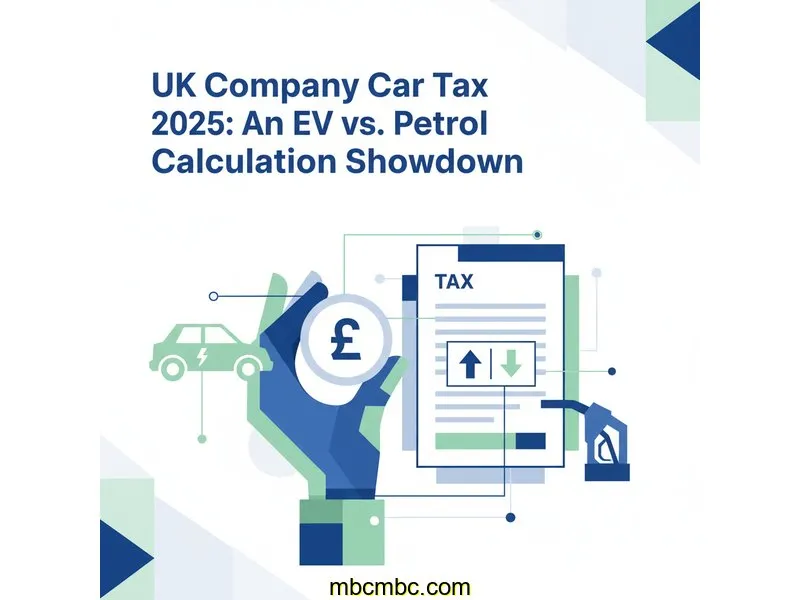
Hi, I'm Alex Williams, founder of FinTools UK. If you're an employee choosing a new company car or a business owner deciding what to offer your team, you've probably realised the choice is more complex than just "petrol or electric". The single biggest factor in your decision might not be the monthly lease cost, but the 'Benefit-in-Kind' (BIK) tax.
This tax, often just called "company car tax," is how HMRC gets its share from this valuable employee perk. The difference in tax between a traditional petrol car and a new electric vehicle (EV) isn't just small; it's a financial game-changer. However, with new rules set to begin from April 2025, the landscape is beginning to shift.
Understanding this is a perfect example of why I build financial calculators—the numbers can be confusing, but seeing them side-by-side makes the best path clear. In this guide, we'll break down the exact calculation, compare a typical EV against a petrol car, and look at the confirmed changes so you can understand the *true* cost.
Key Takeaways: BIK Tax 2025
- What is BIK? Benefit-in-Kind is a tax employees pay on non-cash perks, like a company car.
- The Key Factor: The tax is calculated based on the car's list price (P11D value) and its CO2 emissions. Lower CO2 means a lower tax bill.
- The EV Advantage: For the 2024-25 tax year, zero-emission EVs have a BIK rate of just 2%. Most petrol cars are in the 25% - 37% bracket.
- The 2025-28 Change: The government has confirmed EV BIK rates will rise. From April 2025, the rate increases to 3%, then to 4% in 2026-27, and 5% in 2027-28.
- The Bottom Line: Despite the planned rises, EVs remain overwhelmingly cheaper in tax for both the employee and the employer.
What Exactly is Benefit-in-Kind (BIK)?
Think of Benefit-in-Kind as a "hidden salary." If your employer gave you an extra £5,000 in cash, you'd expect to pay income tax on it. A company car is no different in HMRC's eyes; it's a valuable perk provided *instead* of cash, so it has a "cash equivalent" value that you must pay tax on.
The calculation for your personal tax bill is a three-step formula:
(Car's P11D Value) x (BIK Percentage Rate) = Taxable Benefit Value
(Taxable Benefit Value) x (Your Income Tax Rate) = Total Annual Tax
- P11D Value: This is essentially the car's list price, including VAT, delivery charges, and any optional extras (like a sunroof or metallic paint). It's the total price *before* any discounts or employee contributions.
- BIK Percentage Rate: This is the crucial bit. It's set by HMRC and is based almost entirely on the car's official CO2 emissions. For full EVs, it's 2% (in 2024-25). For a petrol car emitting 130g/km of CO2, this rate could be 31%.
- Your Income Tax Rate: This is simply your personal tax band (20% for basic rate, 40% for higher rate, or 45% for additional rate).
The 2025-2028 BIK Rate Changes You Need to Know
For years, the 2% BIK rate for zero-emission vehicles has been a cornerstone of the UK's push towards electric cars. This incredibly low rate has driven a massive shift; recent HMRC data shows the number of electric company cars grew by over 40% in the last reported tax year alone.
However, this generous discount is now on a confirmed timeline to be reduced. The government has locked in the rates for the coming years to provide certainty:
- 2024-2025 (Current Tax Year): 2%
- 2025-2026 Tax Year: 3% (This 1% rise begins from 6th April 2025)
- 2026-2027 Tax Year: 4%
- 2027-2028 Tax Year: 5%
While any increase is unwelcome, it's important to keep it in perspective. Even at 5%, the BIK rate for an EV will be a fraction of the 25%-37% rates faced by new petrol or diesel cars. The tax advantage remains enormous.
Calculation Showdown: EV vs. Petrol vs. Hybrid (2025/26)
Let's put the formula into practice. Imagine you're a higher-rate (40%) taxpayer in the 2025-26 tax year. Your employer offers you three options, all with a similar P11D value of £45,000.
- Car 1: Full EV (0g/km CO2). BIK Rate: 3%
- Car 2: Petrol Car (140g/km CO2). BIK Rate: 33%
- Car 3: Plug-in Hybrid (PHEV) (40g/km CO2, 45-mile electric range). BIK Rate: 8%
Here's how the annual tax bill would compare for you, the employee:
| Calculation Step | Scenario 1: Full EV | Scenario 2: Petrol Car | Scenario 3: PHEV |
|---|---|---|---|
| P11D Value | £45,000 | £45,000 | £45,000 |
| BIK Percentage Rate (2025-26) | 3% | 33% | 8% |
| Taxable Benefit Value (P11D x BIK Rate) | £1,350 | £14,850 | £3,600 |
| Employee's Income Tax Rate | 40% | 40% | 40% |
| Total Annual Tax (for Employee) | £540 | £5,940 | £1,440 |
Don't Forget the Employer's Costs: Class 1A NI
This isn't just an employee tax. The business also has to pay. Employers pay Class 1A National Insurance contributions (NICs) on the *taxable benefit value* of the car. The Class 1A NI rate is currently 13.8%.
Using the same figures from our table above:
- EV Cost for Employer: £1,350 (Taxable Benefit) x 13.8% = £186.30 per year
- Petrol Car Cost for Employer: £14,850 (Taxable Benefit) x 13.8% = £2,049.30 per year
- PHEV Cost for Employer: £3,600 (Taxable Benefit) x 13.8% = £496.80 per year
As you can see, the business saves over £1,800 *per year, per employee* in NI contributions alone by providing the EV instead of the petrol car. When you multiply this across several employees, the savings for the company become substantial.
How Our Company Car Tax Calculator Can Help
The table above uses just one P11D value and three specific BIK rates. In reality, there are dozens of BIK bands, and every car has a different P11D value. This is where a calculator becomes essential.
Our **Company Car Tax Calculator** is designed to do this heavy lifting for you. Instead of trying to find the correct CO2 band in HMRC's complex tables, you can simply:
- Enter the car's official P11D value.
- Enter its official CO2 g/km.
- For EVs or PHEVs, enter the official electric-only range.
- Select your income tax band.
The tool will instantly show you the taxable benefit value and, most importantly, the actual amount of tax you'll pay for the year. It allows you to quickly compare different models side-by-side to see the real-world financial impact of your choice.
Common Questions About Company Car Tax

When researching this topic, I see the same specific questions popping up on forums like Reddit. Here are the answers to the most common ones.
If my employer pays for my home EV charger, is that a taxable benefit?
Generally, no. As of now, if your employer pays for the installation of a home charging point for a company car, this is *exempt* from being a taxable benefit. This is a significant additional perk designed to encourage EV adoption. However, the electricity *used* to charge the car at home is a different matter and can be more complex.
What's the difference in BIK for a Plug-in Hybrid (PHEV) vs. a full EV?
As the table shows, PHEVs are a good middle ground, but they are not taxed as low as full EVs. The BIK rate for a PHEV depends on its CO2 emissions *and* its electric-only range. For example, in 2025-26, a PHEV with a 45-mile electric range has an 8% BIK rate, while one with a range under 30 miles would be in a higher 14% bracket. A full EV is in its own 3% bracket.
I get a cash allowance instead. Is that always better than taking the company car?
Not necessarily, especially with EVs. A cash allowance (e.g., £500 per month) is simply treated as extra salary. It's added to your paycheque and is subject to both income tax (at 20%, 40%, or 45%) and National Insurance. If you take the cash, you also have to pay for your *own* car, including insurance, tax, and maintenance, out of your *post-tax* income.
With the EV BIK tax being so low (e.g., £540/year in our example), it is often far more tax-efficient to take the EV company car than to take the equivalent cash allowance.
Final Thoughts
The choice between an EV and a petrol company car has a clear financial winner. The tax savings from opting for an electric vehicle are significant, benefiting both the employee's monthly payslip and the employer's balance sheet.
While the new 3% rate from April 2025 (rising to 5% by 2028) means this benefit is slightly reducing, the gap in tax compared to combustion-engine cars remains vast. This guide is for informational purposes to help you understand the mechanics. As a developer, I'm focused on providing the tools to see the numbers clearly, but I am not a financial advisor. It's always a good idea to discuss your specific options with your employer or an accountant to see how these tax rules apply to your personal circumstances.

